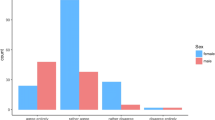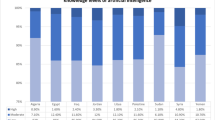Abstract
Purpose
In this study, we aimed to develop a novel prediction model to identify patients in need of a non-contrast head CT exam during emergency department (ED) triage.
Methods
We collected data of all adult ED visits in our institution for five consecutive years (1/2013–12/2017). Retrieved variables included the following: demographics, mode of arrival to the ED, comorbidities, home medications, structured and unstructured chief complaints, vital signs, pain scale score, emergency severity index, ED wing assignment, documentation of previous ED visits, hospitalizations and CTs, and current visit non-contrast head CT usage. A machine learning gradient boosting model was trained on data from the years 2013–2016 and tested on data from 2017. Area under the curve (AUC) was used as metrics. Single-variable AUCs were also determined. Youden’s index evaluated optimal sensitivity and specificity of the models.
Results
The final cohort included 595,561 ED visits. Non-contrast head CT usage rate was 11.8%. Each visit was coded into an input vector of 171 variables. Single-variable analysis showed that chief complaint had the best single predictive analysis (AUC = 0.87). The best model showed an AUC of 0.93 (95% CI 0.931–0.936) for predicting non-contrast head CT usage at triage level. The model had a sensitivity of 88.1% and specificity of 85.7% for non-contrast head CT utilization.
Conclusion
The developed model can identify patients that need to undergo head CT exam already in the ED triage level and by that allow faster diagnosis and treatment.




Similar content being viewed by others
References
Carter EJ, Pouch SM, Larson EL (2014) The relationship between emergency department crowding and patient outcomes: a systematic review. Journal of nursing scholarship : an official publication of Sigma Theta Tau International Honor Society of Nursing 46(2):106–115. https://doi.org/10.1111/jnu.12055
Johnson KD, Winkelman C (2011) The effect of emergency department crowding on patient outcomes: a literature review. Adv Emerg Nurs J 33(1):39–54. https://doi.org/10.1097/TME.0b013e318207e86a
Kellermann A (2006) The future of emergency care in the United States. Medscape Gen Med 8(3):36
Barak-Corren Y, Fine AM, Reis BY (2017) Early prediction model of patient hospitalization from the pediatric emergency department. Pediatrics 139(5):e20162785. https://doi.org/10.1542/peds.2016-2785
Pines JM, Iyer S, Disbot M, Hollander JE, Shofer FS, Datner EM (2008) The effect of emergency department crowding on patient satisfaction for admitted patients. Acad Emerg Med Off J Soc Acad Emerg Med 15(9):825–831
Sun BC, Hsia RY, Weiss RE, Zingmond D, Liang LJ, Han W, McCreath H, Asch SM (2013) Effect of emergency department crowding on outcomes of admitted patients. Ann Emerg Med 61(6):605–611.e606. https://doi.org/10.1016/j.annemergmed.2012.10.026
Chiu IM, Lin YR, Syue YJ, Kung CT, Wu KH, Li CJ (2018) The influence of crowding on clinical practice in the emergency department. Am J Emerg Med 36(1):56–60. https://doi.org/10.1016/j.ajem.2017.07.011
Lauks J, Mramor B, Baumgartl K, Maier H, Nickel CH, Bingisser R (2016) Medical team evaluation: effect on emergency department waiting time and length of stay. PLoS One 11(4):e0154372. https://doi.org/10.1371/journal.pone.0154372
Ginde AA, Foianini A, Renner DM, Valley M, Camargo J, Carlos A (2008) Availability and quality of computed tomography and magnetic resonance imaging equipment in US emergency departments. Acad Emerg Med 15(8):780–783
Raja AS, Ip IK, Sodickson AD, Walls RM, Seltzer SE, Kosowsky JM, Khorasani R (2014) Radiology utilization in the emergency department: trends of the past 2 decades. Am J Roentgenol 203(2):355–360
Broder J, Warshauer DM (2006) Increasing utilization of computed tomography in the adult emergency department, 2000–2005. Emerg Radiol 13(1):25–30
Lee J, Kirschner J, Pawa S, Wiener DE, Newman DH, Shah K (2010) Computed tomography use in the adult emergency department of an academic urban hospital from 2001 to 2007. Ann Emerg Med 56(6):591–596. https://doi.org/10.1016/j.annemergmed.2010.05.027
Ohana O, Soffer S, Zimlichman E, Klang E (2018) Overuse of CT and MRI in paediatric emergency departments. Br J Radiol 91(1085):20170434. https://doi.org/10.1259/bjr.20170434
Stiell IG, Wells GA, Vandemheen K, Clement C, Lesiuk H, Laupacis A, McKnight RD, Verbeek R, Brison R, Cass D (2001) The Canadian CT Head Rule for patients with minor head injury. Lancet 357(9266):1391–1396
Klang E, Beytelman A, Greenberg D, Or J, Guranda L, Konen E, Zimlichman E (2017) Overuse of head CT examinations for the investigation of minor head trauma: analysis of contributing factors. J Am Coll Radiol 14(2):171–176
Mower WR, Hoffman JR, Herbert M, Wolfson AB, Pollack CV Jr, Zucker MI, Investigators NI (2002) Developing a clinical decision instrument to rule out intracranial injuries in patients with minor head trauma: methodology of the NEXUS II investigation. Ann Emerg Med 40(5):505–515
Smits M, Dippel DW, de Haan GG, Dekker HM, Vos PE, Kool DR, Nederkoorn PJ, Hofman PA, Twijnstra A, Tanghe HL (2005) External validation of the Canadian CT Head Rule and the New Orleans Criteria for CT scanning in patients with minor head injury. Jama 294(12):1519–1525
Easter JS, Bakes K, Dhaliwal J, Miller M, Caruso E, Haukoos JS (2014) Comparison of PECARN, CATCH, and CHALICE rules for children with minor head injury: a prospective cohort study. Ann Emerg Med 64(2):145–152, 152.e141-145. https://doi.org/10.1016/j.annemergmed.2014.01.030
Klang E (2018) Deep learning and medical imaging. J Thorac Dis 10(3):1325–1328. https://doi.org/10.21037/jtd.2018.02.76
Dreyer KJ, Geis JR (2017) When machines think: radiology’s next frontier. Radiology 285(3):713–718. https://doi.org/10.1148/radiol.2017171183
Hricak H (2018) 2016 new horizons lecture: beyond imaging-radiology of tomorrow. Radiology 286(3):764–775. https://doi.org/10.1148/radiol.2017171503
Kohli M, Prevedello LM, Filice RW, Geis JR (2017) Implementing machine learning in radiology practice and research. AJR Am J Roentgenol 208(4):754–760. https://doi.org/10.2214/ajr.16.17224
Kruskal JB, Berkowitz S, Geis JR, Kim W, Nagy P, Dreyer K (2017) Big data and machine learning-strategies for driving this bus: a summary of the 2016 intersociety summer conference. J Am Coll Radiol: JACR 14(6):811–817. https://doi.org/10.1016/j.jacr.2017.02.019
Soffer S, Ben-Cohen A, Shimon O, Amitai MM, Greenspan H, Klang E (2019) Convolutional neural networks for radiologic images: a radiologist’s guide. Radiology 290(3):590–606. https://doi.org/10.1148/radiol.2018180547
Zaharchuk G, Gong E (2018) Deep learning in neuroradiology. 39 (10):1776–1784. doi:https://doi.org/10.3174/ajnr.A5543
Schlick CJR, Castle JP, Bentrem DJ (2018) Utilizing big data in cancer care. Surg Oncol Clin N Am 27(4):641–652. https://doi.org/10.1016/j.soc.2018.05.005
Pashazadeh A, Navimipour NJ (2018) Big data handling mechanisms in the healthcare applications: a comprehensive and systematic literature review. J Biomed Inform 82:47–62. https://doi.org/10.1016/j.jbi.2018.03.014
Jiang F, Jiang Y, Zhi H, Dong Y, Li H, Ma S, Wang Y, Dong Q, Shen H, Wang Y (2017) Artificial intelligence in healthcare: past, present and future. Stroke and vascular neurology 2(4):230–243. https://doi.org/10.1136/svn-2017-000101
Shelton R (2009) The emergency severity index 5-level triage system. Dimens Crit Care Nurs: DCCN 28(1):9–12. https://doi.org/10.1097/01.dcc.0000325106.28851.89
Chen T, Guestrin C (2016) XGBoost: a scalable tree boosting system. ArXiv e-prints
Veronika Dorogush A, Ershov V, Gulin A (2018) CatBoost: gradient boosting with categorical features support. arXiv e-prints
Breiman L (2001) Random forests. Mach Learn 45(1):5–32. https://doi.org/10.1023/a:1010933404324
Biau G, Scornet E (2015) A random forest guided tour. ArXiv e-prints
Morotti A, Goldstein JN (2016) Diagnosis and management of acute intracerebral hemorrhage. Emerg Med Clin North Am 34(4):883–899
Brehm A, Tsogkas I (2019) One-stop management with perfusion for transfer patients with stroke due to a large-vessel occlusion: feasibility and effects on in-hospital times. doi:https://doi.org/10.3174/ajnr.A6129
Barbour V, Thakore S (2017) Improving door to CT scanner times for potential stroke thrombolysis candidates–the emergency department’s role. BMJ Qual Improv Report 6(1):u211470. w214623
Emberson J, Lees KR, Lyden P, Blackwell L, Albers G, Bluhmki E, Brott T, Cohen G, Davis S, Donnan G (2014) Effect of treatment delay, age, and stroke severity on the effects of intravenous thrombolysis with alteplase for acute ischaemic stroke: a meta-analysis of individual patient data from randomised trials. Lancet 384(9958):1929–1935
Ivanov MV, Levitsky LI, Bubis JA, Gorshkov MV (2018) Scavager: a versatile postsearch validation algorithm for shotgun proteomics based on gradient boosting. Proteomics 19:e1800280. https://doi.org/10.1002/pmic.201800280
Acknowledgments
This research was performed in collaboration with the Intuit data science expertise team as part of the Intuit philanthropic framework, We Care and Give Back. This study was also conducted with the help of ARC - The Innovation Center at Sheba Hospital.
Funding
None.
Author information
Authors and Affiliations
Corresponding author
Ethics declarations
Conflict of interest
The authors declare that they have no conflict of interest.
Ethical approval
All procedures performed in studies involving human participants were in accordance with the ethical standards of the institutional and/or national research committee and with the 1964 Helsinki declaration and its later amendments or comparable ethical standards.
Informed consent
For this type of study, formal consent is not required.
This article does not contain any studies with human participants or animals performed by any of the authors.
Additional information
Publisher’s note
Springer Nature remains neutral with regard to jurisdictional claims in published maps and institutional affiliations.
Rights and permissions
About this article
Cite this article
Klang, E., Barash, Y., Soffer, S. et al. Promoting head CT exams in the emergency department triage using a machine learning model. Neuroradiology 62, 153–160 (2020). https://doi.org/10.1007/s00234-019-02293-y
Received:
Accepted:
Published:
Issue Date:
DOI: https://doi.org/10.1007/s00234-019-02293-y




